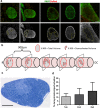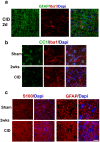Targeted Oligodendrocyte Apoptosis in Optic Nerve Leads to Persistent Demyelination
- PMID: 30848441
- PMCID: PMC7058578
- DOI: 10.1007/s11064-019-02754-z
Targeted Oligodendrocyte Apoptosis in Optic Nerve Leads to Persistent Demyelination
Abstract
The optic nerve represents one of the simplest regions of the CNS and has been useful in developing an understanding of glial development and myelination. While the visual system is frequently affected in demyelinating conditions, utilizing the optic nerve to model demyelination/remyelination studies has been difficult due to its accessibility, relatively small size, and dense nature that makes direct injections challenging. Taking advantage of the lack of oligodendrocytes and myelination in the mouse retina, we have developed a model in which the induction of apoptosis in mature oligodendrocytes allows for the selective, non-invasive generation of demyelinating lesions in optic nerve. Delivery of an inducer of oligodendrocyte apoptosis by intravitreous injection minimizes trauma to the optic nerve and allows for the assessment of oligodendrocyte death in the absence of injury related factors. Here we show that following induction of apoptosis, oligodendrocytes are lost within 3 days. The loss of oligodendrocytes is associated with limited microglial and astrocyte response, is patchy along the nerve, and results in localized myelin loss. Unlike in other regions of the murine CNS, where local demyelination stimulates activation of local oligodendrocyte precursors and remyelination, optic nerve demyelination induced by oligodendrocyte apoptosis fails to recover and results in persistent areas of myelin loss. Over time these chronic lesions change cellular composition and ultimately become devoid of GFAP+ astrocytes and OPCs. Why the optic nerve lesions fail to repair may reflect the lack of early immune responsiveness and provide a novel model of chronic demyelination.
Keywords: Apoptosis; Demyelination; Oligodendrocytes; Optic nerve.
Figures







References
-
- Akassoglou K, Bauer J, Kassiotis G, Pasparakis M, Lassmann H, Kollias G, Probert L. Oligodendrocyte apoptosis and primary demyelination induced by local TNF/p55TNF receptor signaling in the central nervous system of transgenic mice: models for multiple sclerosis with primary oligodendrogliopathy. Am J Pathol. 1998;153(3):801–813. doi: 10.1016/S0002-9440(10)65622-2. - DOI - PMC - PubMed
MeSH terms
Grants and funding
LinkOut - more resources
Full Text Sources
Medical
Miscellaneous

